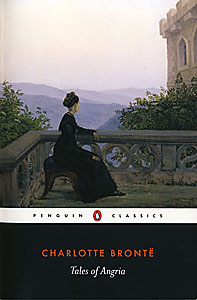 A while back, while in Bolen Books to no good purpose, I expect, I happened on a copy of Charlotte Brontë’s Tales of Angria, a recent edition of the last of her extensive juvenilia, or, alternatively the first of her mature work. The sober cover and Heather Glen’s scholarly introduction suggest that they are to be considered the latter. Glen offers the tales as the response of a sharp, sardonic writerly intelligence to prevailing literary conventions. As a new undergraduate, going wild on my various enthusiasms amongst stacks far removed from my major (Physics, at that time), I worked through much of the collection of books on the Brontës before going on, in zig-zag fashion, to feminism, Ibsen’s plays, Scandinavian women writers, and the films of Ingmar Bergman. Being fascinated by the workings of the imagination, the geography of fantasy, and indeed geography itself, I was intrigued by the Brontës’ imaginary countries, Angria (Charlotte and Branwell), and Gondal (Emily and Anne).
A while back, while in Bolen Books to no good purpose, I expect, I happened on a copy of Charlotte Brontë’s Tales of Angria, a recent edition of the last of her extensive juvenilia, or, alternatively the first of her mature work. The sober cover and Heather Glen’s scholarly introduction suggest that they are to be considered the latter. Glen offers the tales as the response of a sharp, sardonic writerly intelligence to prevailing literary conventions. As a new undergraduate, going wild on my various enthusiasms amongst stacks far removed from my major (Physics, at that time), I worked through much of the collection of books on the Brontës before going on, in zig-zag fashion, to feminism, Ibsen’s plays, Scandinavian women writers, and the films of Ingmar Bergman. Being fascinated by the workings of the imagination, the geography of fantasy, and indeed geography itself, I was intrigued by the Brontës’ imaginary countries, Angria (Charlotte and Branwell), and Gondal (Emily and Anne).
If there were a prose literature for Gondal, as Emily and Anne’s time-capsule diary papers suggests, it has not survived. What has come down to us is the lyrics and ballads written in the voices of the lovers, schemers, fugitives and mourners of Gondal, which include such poems as the elegy that begins, “Cold in the earth, and the deep snow piled above thee,” titled “R. Alcona to J. Brenziada.” Various scholars have tried to fit the poems into a linear narrative, on the basis of internal reference, echoes of style and image, references in the scant diary papers, and cryptic titles laced with abbreviation. Frances Ratchford in 1952 published Gondal’s Queen: A novel in verse, in which she proposed that three of the major female voices were in fact one, that Rosina of Alcona was also Augusta Geraldine Almeda, Queen of Gondal. The reconstruction of Gondal that I find transcribed amongst my papers, in tiny handwriting, was WD Padner’s, from A Brontë Companion, which distinguishes the Queen (AGA) and her lover’s wife and rival (Rosina of Alcona). Ratchford’s justification for conflating the characters was reinforced by analogy to the plethora of names and titles in Angria, but I would like to think that the writer who wrote Wuthering Heights, a novel with such gratifying symmetries underlying its structure, would not be so untidy. Then again, she might well have been, as the extravagance of names captured in the diary papers suggests.
The reawakening of interest has caused me to take out of the library Stevie Davies‘ first book on Emily Brontë, and languish once more in envy of her beautiful prose. On my bookshelves I have Jane Gardam’s quirky coming-of-age novel The Summer After the Funeral, in which the self-controlled, clever, “excellent” daughter of an elderly parson finds a likeness to herself in Branwell’s portrait of Emily and decides she has lived before; it makes an intriguing, moving read. I regret not keeping in my collection Ursula Le Guin’s delicately didactic short novel A Very Long Way from Anywhere Else about the passionate friendship between two gifted young people. Ambitious teenage composer Natalie uses Emily Brontë’s poetry to communicate her vision, and emerging scientist Owen had his own imaginary country, named Thorn. I would venture to suggest that Le Guin’s imaginary country was Orsinia, of the Orsinian Tales (also re-borrowed – “An Die Musik” is no less painful to read, and “The Barrow” no less barbarous) and Malafrena. And I have to find a copy of the recently published Emily’s Journal, which gave rise to a radio play aired last year on Radio 4, “Cold in the Earth, and Fifteen Wild Decembers” that posits the origin of Wuthering Heights in a doomed adolescent romance between Emily Brontë and a local weaver’s son. It seems to be an idea that people like, but which leaves me baffled. The complex, cryptic and potent process of transforming the matter of experience into the matter of the novel is much more interesting. Heathcliff was in all likelihood an immigrant from Gondal.
- See the Complete Poems of Emily Brontë (1908) in the Internet Archive, found courtesy of the BrontëBlog, but bereft of Gondal annotations.
- The British Library on-line images collection has images of some of the Brontë manuscripts, including the first page of Emily’s Gondal Poems notebook.
- Lilia Melani at CUNY has posted some of the poetry on-line, as one of several good pages on Emily.
- An article by Michael JA Howe about the Brontës’ juvenilia (mostly Angria) is on-line at Fathom.